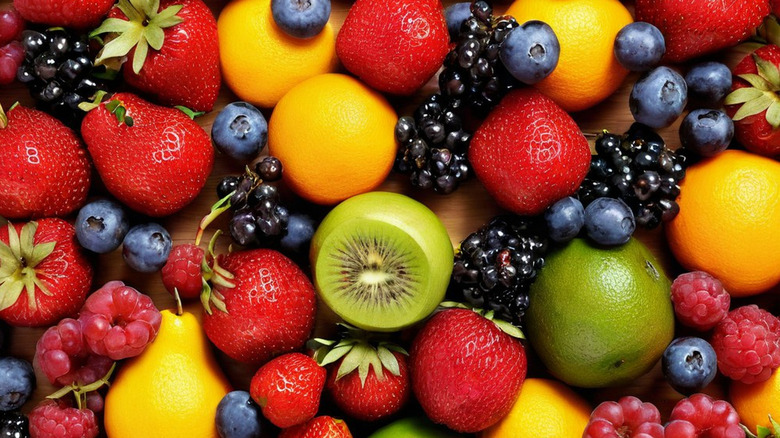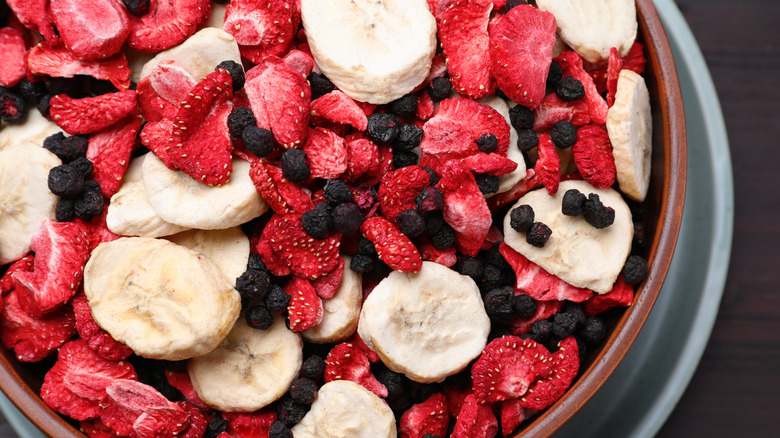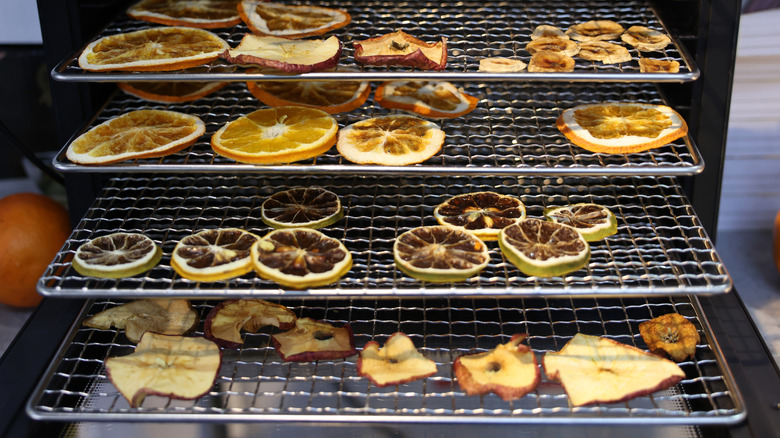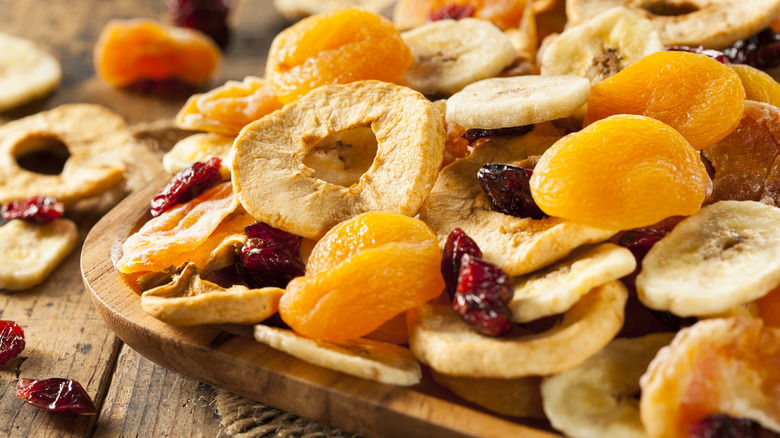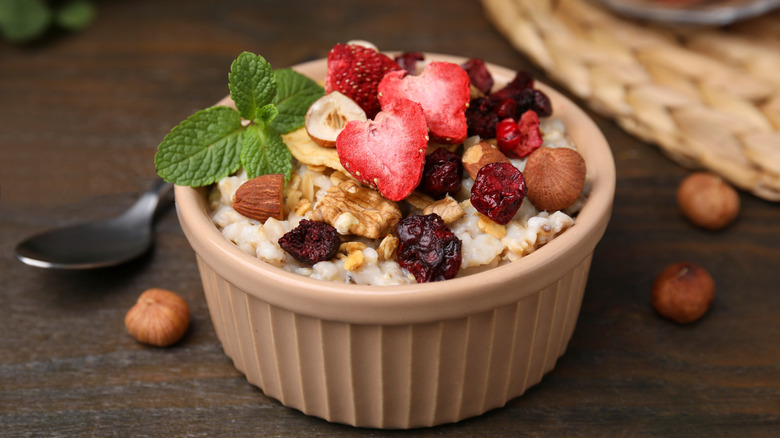Freeze-Dried Vs Dehydrated Fruit: Is There A Difference?
We may receive a commission on purchases made from links.
It's not exactly breaking news that it's important to get your daily serving of fruits, but the specific benefits of doing so may be more impressive than you thought. Fruit is light in calories and heavy in nutrients, including potassium, fiber, and vitamin C. Furthermore, fruit is part of a balanced diet, which can prevent heart disease and even some cancers.
Due to rising prices and limited availability, it can be hard for the average person to meet their daily fruit quota using only fresh fruit. But thanks to the magic of food science, fruit is available in a number of different forms. For example, it can be either freeze-dried or dehydrated. Like delicious canned fruits, both of these methods extend shelf life while retaining nutrients. However, they also have a few differences.
There is a lot of variation between the flavor and texture of freeze-dried and dehydrated fruit. In general, freeze-dried fruit is light and crisp, while dehydrated fruit is dense and chewy. Additionally, freeze-drying preserves nutrients better, whereas dehydration slightly alters the flavor and nutrient composition of the fruit. Read on for the ins and outs of the two processes and what to expect.
What is freeze-dried fruit?
The freeze-drying process involves putting frozen food in a vacuum. As the ice thaws, instead of melting into water, it turns immediately into vapor through a process known as sublimation. This technique removes all the moisture from the fruit without affecting the shape or color, resulting in a product that looks like a crisp, dry version of fresh fruit. Since it shrinks a bit in the process, the flavor of freeze-dried fruit tends to be extra concentrated.
Freeze-dried fruit is sweet and crunchy, making it the perfect topping for cereal or oatmeal (many popular brands already include it). It's also lightweight and has a long shelf life, so it makes a tasty snack for camping and hiking, and is even a good option for emergency supplies. The delicate freeze-dried fruit can also be blended into a fine powder that can be used to flavor batter, frosting, syrup, or practically any other sweet that could use a twist. The one downside is you'll typically have to buy it in-store since the equipment to do it yourself can be very expensive.
What is dehydrated fruit?
As opposed to freeze-dried fruit which requires modern technology, dehydrated fruit goes back millennia. The practice started in the Middle East and Mediterranean, where people would dry fruit like dates by leaving them out in the sun for long periods of time. Today, you can still make dehydrated fruit yourself by using the sun, oven, or a dehydrator, so long as you cook the fruit at a low temperature for a long time.
Dehydrated fruits like prunes, raisins, and apricots are popular snacks often added to trail mixes, baked goods, or savory dishes. It's also easy to upgrade dried fruit with a sour candy twist. You can buy bags of dehydrated fruit at the store, but some commercially available options contain added sugars or preservatives, so make sure to read labels if you want to avoid unnecessary additives. Unfortunately, dehydrated fruit loses some heat-sensitive nutrients, such as vitamin C, during the drying process. However, it is still a healthy snack and contains minerals like potassium and magnesium.
Texture and flavor differences
The most noticeable difference between freeze-dried and dehydrated fruit is texture. Freeze-dried fruit is airy and crisp to the point that it almost dissolves in your mouth, yet it still retains its original shape, albeit smaller. It can be fragile and prone to crumbling, which makes it better for light snacks or as a topping for yogurt and smoothie bowls.
Dehydrated fruit, on the other hand, has a dense, chewy texture since it still has some of its moisture left. It also shrinks during the process and typically has a sticky texture. This makes it a satisfying addition to any recipe that would benefit from some chew, like oatmeal cookies or granola bars.
While freeze-dried fruit retains an intense fruit flavor, dehydrated fruit undergoes flavor changes during the drying process. The heat can take away natural flavors while intensifying the sugar, which can make some dried fruit overwhelmingly sweet — another reason to avoid brands with added sugar.
Nutrients and shelf life
When it comes to nutrients, freeze-dried fruit is the top banana. Since freeze-drying doesn't use heat, it preserves delicate nutrients like vitamin C and antioxidants that tend to degrade during the dehydration process. This makes freeze-dried fruit nutritionally closer to fresh fruit, ideal for those looking to optimize their snacking. Both freeze-dried and dehydrated fruits contain dietary fiber, which helps digestion and heart health. However, the airy texture of freeze-dried fruit may make it easier to overconsume, while the dense chewiness of dehydrated fruit can help with portion control.
In terms of shelf life, freeze-dried fruit lasts longer than dehydrated fruit since it has much less moisture. Freeze-dried fruit can last up to 30 years when stored properly in airtight packaging, making it a go-to choice for emergency kits and hiking trips. Dehydrated fruit is also long-lasting, but more susceptible to the mold and germs that can come with moisture. Expect it to stay good for a year, though it can last up to 20 years in some cases. If you are storing dehydrated fruit, pop it in the fridge to increase its shelf life. Both freeze-drying and dehydrating fruit are excellent methods for long-term storage, but freeze-dried fruit is generally more resistant to spoilage and better suited for portable, moisture-sensitive conditions.
